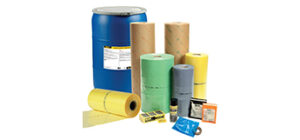In the manufacturing world, many companies go to great lengths to select products and processes to prevent rust and corrosion from forming on their valuable metal assets during transit and storage. They will probably incorporate volatile corrosion inhibitor (VCI) packaging, rust preventative (RP) coatings, desiccants, or some combination of them. But what happens when their rust prevention methods have failed them? When this happens, all too often, they will blame the rust preventive products they used as the reason for the failures. Instead of taking the time to determine the root cause of the corrosion problem, they will look for a different brand or type of rust preventative product in hopes that it will resolve the issue.

The more prudent thing to do would be to investigate the root cause of the corrosion problem. Only by knowing what caused the failure can you select a corrosion prevention solution that addresses the root problem. More times than not, manufacturing companies are surprised to learn that it wasn’t the VCI packaging or RP’s that failed them but rather a flaw somewhere in their process line. Sometimes the solution is a change in the manufacturing process, perhaps a change in the material handling process, or both.
Corrosion prevention can be a complex process as several factors must be considered. Besides selecting protective packaging and/or RP coatings, one must examine the entire process and environment of premanufacturing, manufacturing, and post-manufacturing of their metal assets. Today’s manufacturing procedures require some metalworking fluid(s) (MWF), such as cutting fluids, coolants, wash detergents, and final rinses. The quality and source of the water used to make up these MWFs can determine how successful your corrosion prevention methods will be.

Sometimes some changes are needed, such as the raw metal alloys being used, a change in some of the MWF chemistry, storage or transit time, or perhaps even the final packaging design and materials have changed. When this happens, you must determine if the rust preventative products utilized still meet your demands and are still compatible with your metal alloys.

The good news is that you don’t have to guess or try to figure out what to do independently. ZERUST® implements a proven root cause analysis methodology called Z-CIS® in which our technical staff can provide the necessary assistance on-site or even virtually if preferred. In addition, Z-CIS® is proven to meet the rust-free requirements of various OEMs sourcing from global suppliers. After utilizing our Z-CIS® system, clients generally realize cost savings due to higher yields of rust-free shipments, as high as 100% rust-free.
For more information, please visit www.zerust.com or call (763) 225-6600.
